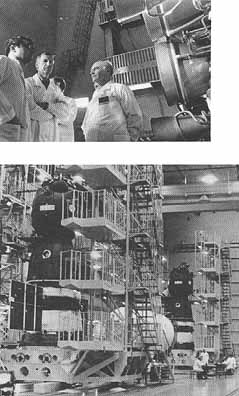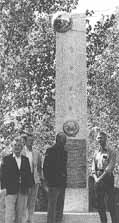
Chapter 10
Final Examinations
[285] In May 1975, George Low traveled once again to the Soviet Union, this time to inspect the Soviet spacecraft and to jointly chair the Flight Readiness Review (ERR). As with the Mid-Term Review, Low's correspondence prior to the meeting had been with Soviet Academy President Keldysh. When the NASA delegation arrived in Moscow, Petrov told Low that Keldysh's health had taken another turn for the worse; he was in the hospital. Three days later Petrov gave Low the news - Keldysh had decided to step down from his post. Vladimir Aleksandrovich Kotelnikov, as acting President, would supervise the FRR for the Soviet side. Kotelnikov, who had a good command of English, at 63 was well known throughout the U.S.S.R. for his textbooks in the field of radio and electronics engineering. While saddened at the news of Keldysh's poor health, Low knew he could work with his successor. But prior to the review, Low and his colleagues visited Baykonur.
Final checkout of the American communications equipment and the docking target alignment tests had been carried out at the Baykonur Cosmodrome during mid-May. This last major activity involved 16 Americans and their Soviet colleagues under the direction of R. H. Dietz and B. V. Nikitin. They had finished their work on the 17th, ahead of schedule, in time for Low; Arnold Frutkin; Glynn Lunney; John F. Yardley, the Associate Administrator for Manned Space Flight; and Walter J. Kapryan, the Director of Launch Operations at Kennedy Space Center (KSC), to visit the cosmodrome on an inspection and orientation tour. Low and his group left Moscow's Vnukovo airport on the afternoon of the 18th. After an evening's stay at the Cosmonauts' Hotel in Leninsk, the five Americans and Professor Bushuyev set out for the launch pad in the van usually reserved for transporting the cosmonauts. Their ride took them through the launch site industrial area to the launch stand.
At the launch pad, they stopped first at a small monument commemorating Sputnik I, which had been launched from this stand on 4 October 1957. Low noted in his trip report:
[This same] pad was used for Sputnik I, for Gagarin's flight, and will be used for one of the ASTP birds. We asked how many launch vehicles had gone off [286] this pad and got two different answers: one being 100 and the second being 300. It was well preserved and painted, and apparently had been repainted prior to our visit. The basic sequencing is all mechanical. The vehicle is not held down but is guided by various arms which are part of the stand. It flies out of the launch pad without holddown, and the arms and booms which support the launch vehicle fall back under counter balance and the force of gravity. Various platforms underneath the launch vehicle are moveable and apparently collapse in a certain way so that they can all be rolled underneath the pad.1
Low also reported that it was very windy at Baykonur. He had been told "that the temperatures in the summertime go to 40°C and in the winter to -40°C," The Soviets indicated that a minimum of work was done out of doors in the winter months.
While at the launch stand, the Soviets and Americans discussed various aspects of launching spacecraft. Bushuyev and Dmitri Bolshakov, the director of the Baykonur Cosmodrome, were interested to learn why the U.S. launch vehicles were held down for a short period of time after the engines were ignited. The Americans explained that this ensured smooth combustion and thrust buildup. Only after the engines were running satisfactorily were the launch vehicles released. Low noted, "apparently [the Soviets] measure the thrust buildup curve for all 20 engines and can shut down during the buildup until just before lift-off." Since they did not need a hold down system, they avoided this complex procedure. The Soviet launch vehicle was also "slightly more efficient . . . from the point of view of fuel consumption," and the Soviets said that they had never lost a launch vehicle as a result of improper thrust buildup.2 From the launch pad, the Americans were taken to the industrial area where the spacecraft were readied for their flights.
Since the industrial sector was only a short distance from the pad and since there were homes and a hotel there, Low asked if this area was evacuated during launches. Bolshakov responded that it was cleared just before a flight. After the Americans were escorted into a huge building that housed the equipment used to check out spacecraft systems, they visited the Soviet equivalent of the KSC vehicle assembly building. Along one side of the building, the prime launch vehicle rested horizontally. The two spacecraft (prime and backup), which the astronauts had examined in April and which Dietz' team had checked out earlier that month, were also housed here. Low recorded that he "spent considerable time walking around the launch vehicle"; he "asked a lot of questions all of which were answered." He had been told earlier that "the same [kind of] launch vehicle had been used since October 1957 and the first Sputnik launch." Low concluded that the Soviets periodically introduced "block changes" into the launch vehicles [287] either to enhance reliability or to replace obsolescent component parts. He continued his report:
We were told that the ASTP launch vehicle is one in a series of which more than 10 have already been flown. The April 5 launch was conducted with a launch vehicle left over from the previous series. The failure of the April 5 launch was explained to us again in detail, and our people appear to be satisfied with the explanation and with the fact that the changes made in the ASTP launch vehicle should prevent this kind of failure. The launch vehicle (all three stages) was on the right hand side of the center aisle. On the left side were the two spacecraft and the spacecraft shrouds. The launch vehicle was horizontal; the spacecraft were vertical. In order to place the spacecraft inside the shrouds, they are tipped to a horizontal position and cantilevered horizontally from the launch stand. The shroud is then slid over the spacecraft and attached to the bottom ring. At some point in the process, the spacecraft is then taken out on a railroad car and fueled. Then the launch vehicle and spacecraft are mated in a horizontal position on the car which ultimately takes them to the launch pad.3
The Americans spent the remainder of their visit to Baykonur attending a briefing on the communications electromagnetic compatibility tests just...
|
|
 |
|
Above, George Low (right) visits the Soviet monument commemorating the launching of Sputnik I in October 1957. Others present are, left to right, W. J. Kapryan, G. S. Lunney, and A. W. Frutkin. Inside the Manned Spacecraft Assembly Building at Baykonur, George Low (center), Professor Bushuyev, and the Soviet interpreter listen to a briefing on the Soyuz launch vehicle. The first-stage engine nozzles are visible at the far fight. Both ASTP Soyuz spacecraft are being readied for the joint mission. The extended solar panels will be folded back so that the protective launch shroud (white cylinder to the left of the far craft) can enclose the spacecraft (Soviet Academy of Sciences photo). |
[288] ...completed, touring the Korolev and Gagarin cottages at the launch site, and visiting Leninsk. During the stop at the Korolev house, the Americans got a rare insight into Bushuyev's past. Throughout ASTP, the Soviets had given the Americans little information about their personal backgrounds in the space program. But when the U.S. team visited Korolev's cottage, "Bushuyev told us that he spent much time there with Korolev and apparently stayed there on several occasions," Low noted. On further questioning, Bushuyev told them that he had started working with Korolev right after World War II on the launch vehicle for Sputnik and on the spacecraft, too. Since then, he said, he had concentrated mostly on spacecraft. The Americans and their Soviet hosts then returned to Moscow for the FRR.4
1. George M. Low, "Notes from Visit to Soviet Union, May 17-23, 1975," 5 June 1975.
4. Ibid.
Next
